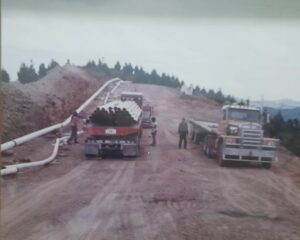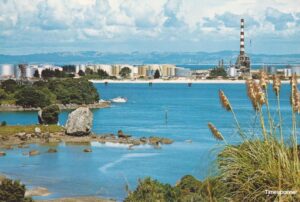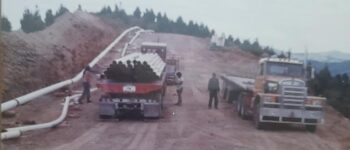1985: Refinery to Auckland Pipeline
June 6, 2023
By AHNZ
 This month in New Zealand history, June, 1985, the Refinery to Auckland Pipeline (RAP) was officially opened. Just as the blood vessels sustain the life force of a living organism, the RAP served as conduits, channeling the vital energy of refined petroleum products from the Marsden Point Refinery to the heart of Auckland, nurturing the economic vitality of the nation. In this analogy the Marsden Point refinery meant that New Zealand was ‘chewing its own food’ with its own digestive system for crude oil to generate the various products we needed. Before the Refinery (1964) we were like a baby bird being fed from a parent. Before the pipeline we didn’t have the infrastructure to get the energy from ‘stomach’ to the vital organs that needed feeding.
This month in New Zealand history, June, 1985, the Refinery to Auckland Pipeline (RAP) was officially opened. Just as the blood vessels sustain the life force of a living organism, the RAP served as conduits, channeling the vital energy of refined petroleum products from the Marsden Point Refinery to the heart of Auckland, nurturing the economic vitality of the nation. In this analogy the Marsden Point refinery meant that New Zealand was ‘chewing its own food’ with its own digestive system for crude oil to generate the various products we needed. Before the Refinery (1964) we were like a baby bird being fed from a parent. Before the pipeline we didn’t have the infrastructure to get the energy from ‘stomach’ to the vital organs that needed feeding.
Ships couldn’t keep up with all the products sent to Freeman’s Bay in Auckland but a pipeline could do it and with more efficiency. We should also suspect that wharfies were in a prime position to exploit sea traffic and hold up fuel ships which would hold the country to ransom. The RAP was much more reliable and almost immune to politics and labour market disruptions. Going along with the analogy of New Zealand as Leviathan (Thomas Hobbes) or a Corporate Organism (Herbert Spencer) the managers at Marsden Point even referred to the control room of the pipeline as “the brain.”
According to Warkworth Museum’s photo board (image, left) this was New Zealand’s largest ever pipeline project and was actually 2 pipelines not just 1. Natural gas had its own pipeline to carry product from Auckland north to Whangarei. The section of the pipeline to Henderson Valley was completed on 17 May, 1982.
“1964 saw the commissioning of the Marsden Point Refinery — the ushering in of a new energy era for New Zealand. The New Zealand Refining Company’s complex ended this country’s total reliance on costly, imported petroleum products. The demands of an increasingly fuel-hungry New Zealand could be met in part, at least, by local processing of imported crude.
“Twenty one years later, the refinery “comes of age” with a 170 km pipeline that links Marsden Point and a new bulk storage depot at Wiri, South Auckland.
“150 invited guests gathered at the Marsden Point Refinery to celebrate the official opening of the Whangarei to Auckland fuel pipeline. During a tour of the refinery the guests visited the sophisticated control room which is the “brain” of the pipeline.” – Marsden Point Refinery Pipeline Completed, Press (28 June, 1985, ) Papers Past
“With the expansion of the Marsden Point Refinery, the New Zealand Refining Company proposed a transportation system to move refined oil products through a high-pressure steel pipeline to the oil terminal in Wiri, South Auckland. Simultaneously, the Natural Gas Corporation of New Zealand aimed to extend its gas network from an existing system in Auckland to Whangarei. To optimize efficiency, it was agreed that the oil and gas pipelines would be laid in a shared trench.”
“This ambitious pipeline project, the largest ever undertaken in New Zealand by a wholly New Zealand-owned organization (Perry Dines Limited), involved the completion of two pipelines spanning 157 kilometers from Marsden Point to Henderson Valley. The workforce required for the construction of this $50 million project reached its peak of 250 workers on 17 May 1982 and concluded within the contractual timeframe, earning Perry Dines Limited the esteemed “Contract of the Year Award 1985” from the New Zealand Contractors Federation “Contract of the Year Award 1983.” – Warkworth Museum panel (accessed 2022.)
“The Marsden Point to Auckland Pipeline is a critical part of New Zealand’s fuel supply chain. Built in the 1980’s it traverses farmland, towns and part of the Manukau Harbour. It supplies most of Auckland’s fuel requirements and all of the jet fuel to Auckland International Airport.” – channelnz.com“
It was all pretty great achievement, especially in terms of making New Zealand more into a first-rate country with autonomy and capacity over its own energy supply. Yet, few are even aware of this key bit of infrastructure.
Auckland Bleeding
The most attention the pipeline ever got was after 14 September 2017 when the line ruptured in a Ruakaka paddock. This was a crisis timed just 9 days before the General Election which certainly hurt the Government, National 5.0, and helped lead to their replacement by a coalition of Labour and New Zealand First (Labour 6.0 Ministry.) Auckland Super City was on rations and the airport had to cancel flights and send aircraft off with less fuel in their tanks than usual. Air New Zealand chief executive Christopher Luxon was having a really tight time and his staff much have juggled some pretty impressive logistical balls.
Yet this should never have happened! As the Department of Internal Affairs report (August 2019) pointed out the fuel supply to Auckland, on which millions of lives depend, was all tied to the fate of this one, vulnerable, pipe. “We have concluded that there is a need to invest in further infrastructure without delay, to achieve an acceptable level of resilience.” they said. Auckland had been brought to its knees because somebody in 2014 is assumed to have nicked the pipeline with their digger leading to the eventual rupture! We don’t even know his name or if he was held to account. You’d get more time in jail for accidentally cutting someone’s artery or ram-raiding a petrol station than what happened when an entire city had its jugular cut.
Old New Zealand would never be so blase leading up a crisis like this nor complacent afterwards as we are now. If some foreign power wanted to make war on us and hold us hostage it wouldn’t need an army or a bomber raid. It would just need to send one guy down to Hirepool for a digger and we’d be stuffed. This isn’t hypothetical, this is history!
“Flights were disrupted or cancelled for about 10 days until the pipeline was repaired. Air New Zealand chief executive Christopher Luxon said the disruption cost his airline about $5m and it was looking at ways of recouping that.” – Pipeline failure wipes out $8.2 million of profit at New Zealand Refining, NZ Herald (2018)
“International travelers booked on four flights out of Auckland are the latest victims of the fuel crisis.” – More international flights cancelled, ODT, (September 2017)
“With only a single supply chain for jet fuel, a single point of failure at any point along that chain can cause a complete disruption of supply to Auckland Airport. There is limited storage near the airport to provide cover for an outage and the number of days of cover that storage provides is decreasing as the daily demand for jet fuel grows. This means our vulnerability is increasing.”
“Northland Regional Council group manager of regulatory services Colin Dall said the fuel leak – estimated at 124 cubic metres – was a breach of the Resource Management Act but the council “does not have a case for prosecution”. – NZ Herald (2018)
The pipeline at least still works. Unfortunately, as of 2022, the refinery once touted as ushering in of a new energy era for New Zealand and ending its dependence on foreign supply, has been permanently shut down and dismantled. Quietly started digesting energy as the oil stomach of the New Zealand leviathan since 30 May, 1964: Marsden Point oil refinery at Reotahi, Whangarei, is no more.
Pouring Concrete into New Zealand’s Belly
 If New Zealand is a corporate organism then it now has concrete poured into its belly because that is what has been done at Marsden Point. Still alive, the food that powers us is digested offshore and we are fed this pre-chewed food through a supply tube of many tankers when before just a few would do.
If New Zealand is a corporate organism then it now has concrete poured into its belly because that is what has been done at Marsden Point. Still alive, the food that powers us is digested offshore and we are fed this pre-chewed food through a supply tube of many tankers when before just a few would do.
Set to work on 30 May, 1964, Marsden Point Oil Refinery started producing until a stop was put to it in 2022. Press reported soon after opening that the refinery “has quietly been making products for the last two or three days, the general manager (Mr J. Carney) said..” Ref. Press (1964,) Papers Past
“On April 1 2022 the company formerly known as Refining New Zealand Ltd. closed down New Zealand’s biggest refinery (Marsden point) and no longer plans to refine oil onshore…The refined fuel products produced at Marsden point were some of the finest grade in the world and the cheaper and nastier fuels that are now being imported are of inferior specifications and grades..” – operationgoodoil.co.nz
New Zealand’s energy lifeblood is still oil and for 60 years we could digest our own. This value-added economy saved us money and also made New Zealand more energy secure. We now get our energy as if a sick man on an intravenous drip.
“The revelation that the government is allowing the Marsden Point Oil Refinery pipes to be filled with concrete shows an astonishing level of economic ignorance,” says Rt Hon Winston Peters Leader of New Zealand First. “This removal of any future use of these pipes at Marsden Point is not a part of the decommissioning process – it is a private company being allowed to commit blatant economic treason,” – New Zealand First press release, Scoop (March 2022)
“Government has decided to take over the bitumen import business in New Zealand because it doesn’t trust private enterprise…Because New Zealand can’t make its own oil-infested rocks now we must ship in the expensive and heavy stuff. Because Labour 6.0 had Marsden Point oil refinery closed down and concrete poured into the workings. Because tar/bitumen is a strategic national commodity the Government needs to be in control of its import. Because tar/bitumen is a strategic national commodity the Government shut down our own domestic suppler of it. Go figure that out would you?” – Nationalisation of Tar, NZB3 (2022)
Not only did Labour 6.0 shut the plant down they sabotaged it so it could not run again. It all seems a bit too weird for State History to explain. A celebrated infrastructure: abandoned. An essential pipeline: ruptured by ‘nobody’. A $365,000,000 investment in 2012 but total shut-down and dismemberment just 10 years later. Does this really make sense?
- 1964 Refinery online
- 1984 Whangarei Refinery Expansion Project Disputes Act: Industrial dispute dealt with by rushed legislation, bypassing select committee. Ref. 1984: The Fall of Fortress New Zealand
- 1985 RAP online
- 1988 Petroleum Sector Reform Act: Labour 4.0 ‘sold’ Marsden Point Refinery along with a gift of $80,000,000 to ‘help’ the new owners ‘adapt’ Ref. Wiki
- 2012 $365m upgrade for Marsden Point, Ref. NZ Herald (2012)
- 2014 Pipeline audit shows no damage
- 2014 Anonymous digger driver looking for swamp kauri allegedly damages the RAP
- 2017 Damaged RAP ruptures causing a crisis for Auckland
- 2017 Sixth Labour Government
- 2018 Refinery CEO Resigned. Ref. NZ Herald (2018)
- 2021 Refining NZ shareholders voted to stop refining oil
- 2022 Marsden Point Refinery shut down and started dismantling the plant
- 2022 Labour Minister says Government will be taking over the bitumen import industry. Ref. NZB3
The Anarchist take on this matter is to apply the usual Anarchy 101 analysis of politics. The Anarchist political school says New Zealand’s national politics is a Capture The Flag style game between Team Blue and Team Red. The idea is to gain and keep the power of the Executive Government. This is achieved by capturing all of New Zealand’s revenue-generating castles in every industry or else destroying them.
National built the refinery in the 60s and expanded it in the 80s. It was a Team Blue project. Labour took it off then hands, selling it. Now it was a Team Red concern or at the very least not Team Blue.
Team Blue apparently the patrons of Marsden Point Refinery again by 2010s, the time of John Key’s Ministry. $365 Million invested.
Then, in 2017, Labour 6.0 takes power and the RAP ruptures almost in the same week. Team Blue affiliate and future Leader, Chris Luxon of Air New Zealand, is left howling in pain. The Refinery CEO quit his job. Shortly after Labour 6.0 were re-elected in 2020 the Refinery owners decide to call it quits. They were probably holding out for their patron, Team Blue, to win but as they did not a shutdown is decided upon in 2021 and effected in 2022.
Even if Team Blue were to win power again this particular ‘castle’ is off the political chess board now. As they can’t control it, Team Red has had it scrapped. None of this has anything to do with the good of the economy or the people. It’s simply the Capture the Flag politics game ruling over our lives.
It’s a cynical pattern to recognise but what explains this odd history better? Do you prefer to believe in the mystery digger damage timebomb that flared up during election week 2017? Do you prefer to believe a $365 million dollar investment followed by total scrapping of the entire refinery infrastructure makes good business sense? Do you think the government is being wise when it decided to make the nation dependent on importing jet fuel, petrol, diesel, roading bitumen, CO2 gas etc. instead of making our own? Or, is it Shenanagans and we’re being fed propaganda at a time when we should be alert?
—
Image ref. Refinery, Timespanner Collection, Facebook (2018)
Image ref. Laying the pipes, Warkworth Museum panel (accessed 2022.)
Note: “What could have been explained away as teething problems with imported aviation fuel is looking increasingly to be a systemic issue and it’s time for oil companies to clean up their act…third case within six months third case within six months of imported refined aviation gas not being up to the exacting specifications for aviation.” – Editorial: Oil companies need to clean up their act over dirty aviation fuel. NZ Herald (May 2023)
One thought on "1985: Refinery to Auckland Pipeline"
Leave a Reply
 Like Comment Share
Like Comment Share







The feeling of being manipulated is sickening and the concrete confirms it.